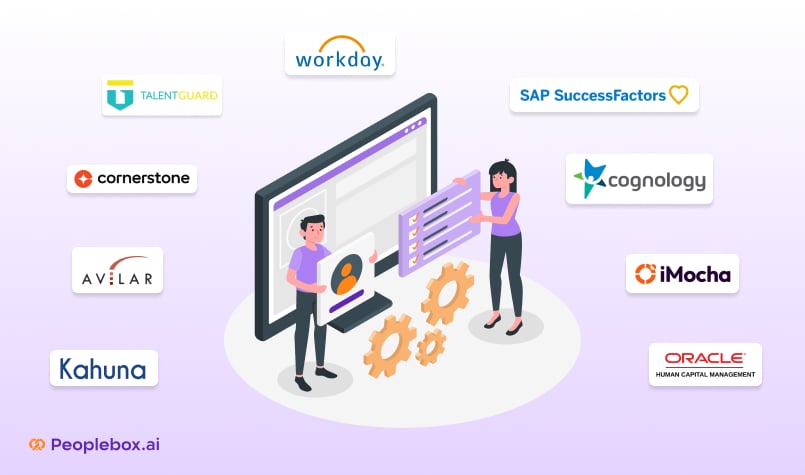Performance reviews help assess employee performance and set the stage for improvement.
But there’s a challenge: preparing for these reviews can be overwhelming.
Imagine your desk piling up with papers, meetings filling your calendar, and the pressure building up. You know these reviews are essential for employee growth and your company’s success. It’s not just about doing the review; it’s about doing it well. It’s about ensuring each review is a positive conversation that helps your team and aligns with your company’s goals.
Before we delve into the specifics of preparing for performance reviews as a manager, let’s emphasize why this preparation matters:
For Managers:
- It enables you to offer fair and constructive feedback.
- It helps set clear expectations for your team members.
- It contributes to employee development and career growth.
- It aligns individual goals with the broader objectives of the organization.
For Employees:
- It provides a platform to showcase achievements and contributions.
- It offers an opportunity to discuss career aspirations.
- It identifies areas for improvement and professional growth.
- It encourages open communication between managers and employees.
In this blog post, we’ll tackle this challenge head-on.
We’ll also explore:
- How to prepare for a performance review?
- Strategies, tips, and best practices to make this process smoother
How to Prepare for a Performance Review?
Performance reviews are not just about evaluating an employee’s past performance; they are essential opportunities to set the stage for future growth and success, both for the individual and the organization. As an HR manager, thorough preparation for these reviews is your key to making them productive and meaningful. Here’s how you can prepare effectively:
1. Set Clear Objectives

The first step is to establish clear objectives when preparing for a performance review. These objectives serve as the foundation for the entire review process.
Consider the following points:
- Purpose of the review: Determine the primary purpose of the review. Is it to assess an employee’s progress, discuss career development, provide feedback, or set goals for the upcoming year?
- Defining goals: Clearly define the goals you want to achieve during the review. For example, you might aim to align the employee’s performance with organizational objectives, identify areas for improvement, or acknowledge outstanding contributions. Having a clear understanding of the review’s purpose and goals will guide your preparations and ensure that the review remains focused and productive.
2. Gather All the Information
You need to gather comprehensive information about the employee’s performance to conduct an effective performance review. Here’s how to go about it:
- Job responsibilities and previous performance: Review the employee’s job responsibilities as outlined in their role description. This helps you understand the expectations associated with their position. Additionally, look at their previous performance evaluations to gain insights into their historical performance trends.
- Accomplishments and contributions: Collect data on the employee’s achievements and contributions since the last review. This includes any significant projects they’ve been involved in, key milestones they’ve reached, or positive impacts they’ve made on the team or organization.
- Specific instances: Document specific instances of exceptional performance as well as areas where improvement is needed. Concrete examples make your feedback more credible and actionable.
- Feedback from others: Solicit feedback from team members and other relevant reports. This 360-degree feedback offers a broader perspective on the employee’s performance, highlighting strengths and areas for growth from different viewpoints.
- Key performance indicators (KPIs) and metrics: Evaluate the employee’s performance against relevant KPIs and metrics. This quantitative data provides a factual basis for assessing performance.
- Additional data sources: Consider additional data sources, such as self-assessments and HR reviews. These sources can provide valuable insights and contribute to a more holistic review.
3. Prepare Questions and Examples
Anticipating your employee’s questions and preparing specific examples to support your responses is essential for a productive review.
Here are some questions to consider:
- Strengths and areas for improvement: Be ready to discuss the employee’s strengths and areas where improvement is needed in their current role. Provide specific examples to illustrate your points.
- Career development prospects: Address questions about career development within the organization. Discuss potential career paths, growth opportunities, and actions the employee can take to advance.
- Performance benchmarks: If the employee inquires about pay raises or promotions, explain the benchmarks they need to meet and provide guidance on how to work toward those goals.
- Compensation package: If questions about compensation arise, be prepared to evaluate the employee’s current package and suggest potential improvements or adjustments.
- Progress on goals: Discuss progress regarding the goals and objectives established at the beginning of the year. Highlight areas of achievement and areas that require further attention.
4. Identify Areas of Improvement

Recognizing and addressing areas where improvement is needed is a crucial part of the performance review.
Begin by acknowledging the employee’s strengths and contributions to create a positive tone.
Then, identify areas for growth and suggest actionable steps:
- Incorporating feedback: Encourage employees to seek and incorporate feedback into their work actively. Discuss the value of continuous improvement.
- Time management: If time management is an issue, guide strategies to effectively enhance productivity and meet deadlines.
- Communication skills: Offer tips on improving communication skills, both within the team and with stakeholders. Effective communication is often a key skill for career growth.
- Leadership development: If relevant to the employee’s role or career aspirations, discuss leadership potential and suggest avenues for leadership skill development.
- Setting personal KPIs: Collaborate with the employee to set personal Key Performance Indicators (KPIs) that align with their role and the organization’s objectives. These KPIs should be specific, measurable, and achievable.
- Critical thinking: Encourage the development of critical thinking abilities to solve complex problems and make informed decisions. Critical thinking is a valuable skill for career advancement.
5. Prepare for Difficult Conversations
Performance reviews may involve sensitive or challenging topics, such as areas where improvement is needed.
It’s essential to approach these discussions with empathy and a data-backed approach:
- Empathy: Prepare to address sensitive topics with empathy and understanding. Acknowledge that the goal is growth and development, not criticism.
- Data-backed statements: Ensure that specific examples and data support your feedback. Use concrete evidence to make your points, and avoid making judgments based on assumptions.
- Positive and supportive tone: Maintain a positive and supportive tone throughout the discussion. Emphasize that the goal is to help the employee succeed and overcome challenges. In case where you have to give negative feedback to an employee make sure it is given constructively.
6. Prepare to Set Development Goals
Collaborating with the employee to set development goals is a critical aspect of the review process.
Here’s how to approach it:
- SMART goals: Work together to establish SMART (Specific, Measurable, Achievable, Relevant, Time-bound) development goals. These goals should be clear, quantifiable, attainable, aligned with the organization’s plans, and have a defined timeline. Here are 55+ employee smart goal examples for inspiration.
- Alignment: Ensure that these development goals align with the employee’s career path and the company’s broader objectives. Discuss how achieving these goals will contribute to their professional growth and the organization’s success.
7. Plan for Open Communication
Creating an environment of open communication during the review is essential for fostering trust and transparency:
- Encourage sharing: Encourage employees to share their perspectives, concerns, and career aspirations. Actively listen to their input and demonstrate that their voice matters.
- Two-way conversation: Remember that the performance review is a two-way conversation. Be receptive to feedback from the employee and consider their input seriously.
- Trust building: Building trust through open and honest communication is key to a successful review. Ensure that the employee feels comfortable sharing their thoughts and concerns.
Thorough preparation for a performance review as an HR manager is not just a professional duty; it’s a valuable investment in your team’s growth and success. By following these detailed steps, you can confidently navigate performance reviews and help your employees thrive. Effective performance reviews are about assessing the past and shaping a brighter future for both individuals and the organization.
Tips for Making Performance Reviews Smooth Every Time
Here are some additional tips to ensure smooth and effective performance reviews:
1. Schedule Performance Reviews at Regular Intervals
Consistency is key when it comes to performance reviews.
By scheduling reviews at regular intervals, such as annually or semi-annually, you create a predictable cadence for employees. This sets expectations and allows employees to track their progress over time.
Regular reviews also provide a structured framework for managers to assess and discuss performance.
2. Customize the Review Templates for Each Employee
No two employees are exactly alike, and their goals, challenges, and responsibilities may vary significantly.
To make performance reviews meaningful, customize the review templates for each employee. Tailor the performance review questions and assessment criteria to align with individual roles and objectives.
This personalization demonstrates your commitment to understanding and supporting each team member’s unique journey within the organization.
3. Double-Check Your Employee Data for Accuracy

Data accuracy is paramount in performance reviews.
Ensure that all employee data, including performance metrics, goals, and achievements, is up-to-date and accurate. Inaccurate data can lead to misunderstandings and hinder the review process.
Double-checking data helps maintain the integrity of the review process and ensures that discussions are based on reliable information.
4. Focus on the Employee’s Aspirations and Expectations
Performance reviews should not solely be retrospectives of past performance. They are also an opportunity to align the employee’s aspirations and expectations with the organization’s mission and goals.
Encourage employees to share their career goals, ambitions, and what they expect from their role.
Understanding their aspirations can help create a career path aligning with their personal growth and the organization’s strategic objectives.
5. Provide Constructive Feedback with Specific Examples and Actionable Recommendations
One of the central purposes of a performance review is to provide feedback. However, vague or generalized feedback can be unhelpful. Instead, offer specific examples of an employee’s accomplishments and areas for improvement.
Constructive feedback should be actionable, suggesting tangible steps for improvement. This clarifies expectations and empowers employees to take concrete actions to enhance their performance.
6. Collaborate with Employees to Create an Action Plan for Their Growth
The performance review should not be a one-way conversation.
Collaborate with employees to create an action plan for their professional growth. This plan should outline specific goals, timelines, and resources needed to achieve those goals.
It empowers employees to take ownership of their development while ensuring that their growth aligns with organizational objectives.
7. Avoid Making Assumptions; Ask Questions for Clarity
Assumptions can lead to misunderstandings and missed opportunities for improvement.
Ask questions for clarity instead of assuming you understand an employee’s perspective.
Encourage open dialogue where employees can express their thoughts, concerns, and ideas. This fosters a culture of transparency and ensures that both parties have a shared understanding of expectations.
8. Make an Effort to Reduce Biases in the Review Process
Unconscious biases can inadvertently influence the review process.
To mitigate this, focus on objective data and measurable outcomes. Base your evaluations on specific criteria and evidence rather than subjective impressions.
Training and awareness programs can also help reduce biases among managers and create a more equitable review process.
9. Encourage Feedback from Employees About the Review Process
Feedback isn’t a one-way street.
Encourage employees to provide feedback about the review process itself.
Ask them about their experience during the review, whether they felt their concerns were addressed, and if they have suggestions for improvement.
Act on this feedback to continually enhance the review process and make it more effective and employee-centric.
10. Always Follow Up After the Review to Monitor Progress and Provide Ongoing Support
To prepare for performance review isn’t a standalone event; it’s part of an ongoing dialogue.
After the review, follow up with employees to monitor their progress toward their goals. Offer ongoing support, including additional training, resources, or mentorship.
Regular check-ins ensure that the action plan created during the review is on track and that employees continue to feel valued and supported.
Incorporating these tips to prepare for the performance review process can transform it into a constructive, growth-oriented, and employee-centric practice. By maintaining consistency, personalizing the experience, ensuring data accuracy, and fostering open communication, HR managers can create a performance review process that benefits both employees and the organization as a whole.
Redefine Performance Reviews With Peoplebox
Your role in the performance review preparation process is important, and thorough preparation is crucial.
To make things easier and better, you can try using Peoplebox. Peoplebox is a tool that helps HR managers with employee effective and bais-free performance reviews. It has all the features you need and customization to implement your own performance management playbook. Peoplebox makes the process easy and flexible.
With the right tools and a commitment to improving, your performance reviews can help your team and your organization succeed even more.







